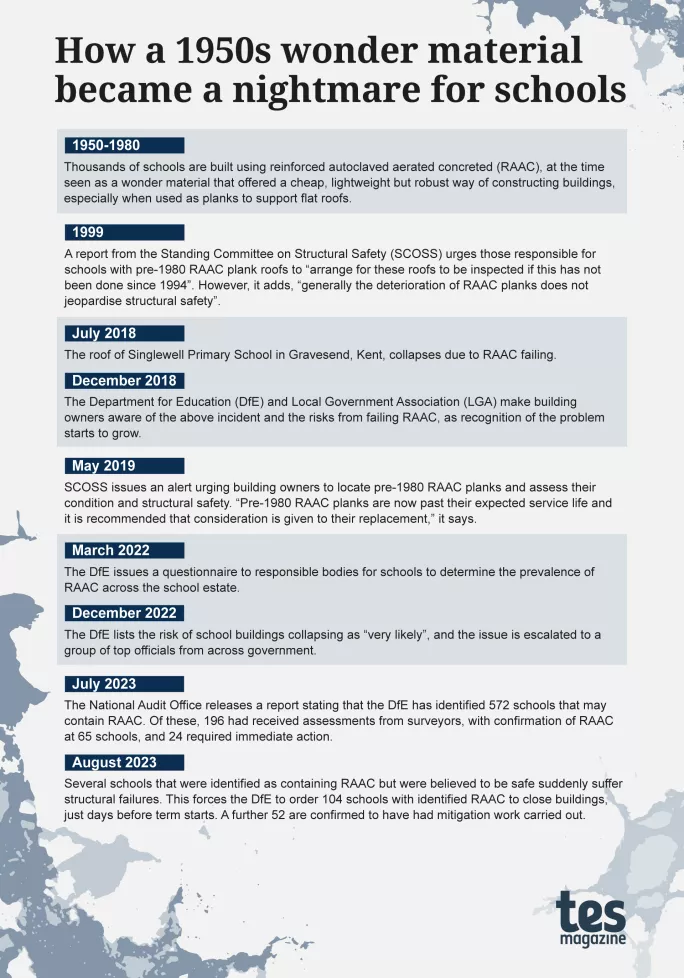More than 100 schools advised to close buildings due to concrete risk

Schools are understood to be being advised this week to vacate all buildings containing a concrete at risk of collapse - days before the start of the new term - due to safety concerns.
Documents seen by Tes thought to be from the Department for Education state current advice is that all school areas containing reinforced autoclaved aerated concrete (RAAC) “should be taken out of use and mitigations should be implemented immediately”.
The document adds that the order should be carried out “regardless of the risk rating” of the RAAC in a particular area of the school.
The DfE has this afternoon issued new official guidance for 104 schools that have been identified as having an RAAC-related safety risk within their buildings but do not currently have measures in place to prevent collapse.
The measures will trigger full or partial relocation due to the extent of RAAC present on their sites in a minority of schools, the DfE said.
However, the DfE advises that if schools are experiencing high levels of disruption due to building closures they should prioritise pupils who are vulnerable, or whose parents are critical workers and those set to take exams - similar to measures put in place during the Covid lockdowns.
- School attendance: Seven changes schools should know about
- Big issues in education: Four key questions for the coming school year
- Ofsted: Schools face scrutiny on youth violence
The DfE said this afternoon that 156 schools have confirmed RAAC - but only 52 of these already have mitigation in place.
School building closures ‘may come as a shock”
A script included in the earlier leaked documents - understood to be for DfE officials contacting schools this week to advise them of the need to close down unsafe buildings - reads: “I appreciate this may come as a shock and is likely to cause disruption but the safety of pupils, students and staff is our priority.”
The documents advise that RAAC school areas can stay in use if appropriate mitigations, such as the propping up of risky walls, are in place.
School leaders are advised to identify areas where teaching could be temporarily relocated to in surrounding schools and the local authority.
In some cases, the documents state, it may be required for whole year groups to be “displaced across multiple schools”.
It is further advised that areas with suspected but not confirmed RAAC should be treated as if it is present if they are in the same block as or similar to confirmed cases.
RAAC is a lightweight form of concrete with an estimated life of 30 years. A safety warning was issued in 2018 after the collapse of a Kent primaryschool’s roof made of RAAC.
The DfE ‘needs to be better’
The DfE has been accused of causing confusion and uncertainty over the issue just days before term starts.
Multi-academy trust CEOs have told Tes that the DfE has called them about schools in their trusts built with RAAC, but some are questioning assertions that their schools are unsafe.
This comes after it emerged earlier this week that schools identified as having buildings containing RAAC were being asked to come up with contingency plans days before term starts.
One CEO of a large MAT told Tes: “We are held to high standards by [the DfE], they need to be better than this.”
The DfE was understood to be ringing schools earlier this week to make sure they were prepared to evacuate if needed.
Documents seen by Tes state that the DfE had “serious concerns” about the integrity of RAAC after engineers assessed its condition - though it had not previously been advised for schools to vacate RAAC areas until now.
The documents include an earlier script for officials to use when calling schools, outlining how to ask them if “mitigations such as propping, failsafe, strengthening works are already in place”.
Engineers are understood to have rated the severity of RAAC in schools from “high critical” (needing immediate action with areas requiring closure) to high, medium and low. The documents state actions required have included schools carrying out their own surveys and establishing monitoring plans.
The earlier script warned schools that they need to prepare to be able to stop using buildings with RAAC at short notice.
The documents state that the DfE will provide funding for mitigation works needed, such as propping up and strengthening works and providing temporary classrooms in the short and long term.
They reveal that project directors have visited some schools already and will be visiting the rest to determine what work is required and the funding options.
‘A race against time’
Labour politicians, union leaders and experts have condemned the warnings coming days before the start of term next week.
Academy consultant Tim Warneford told Tes: “The threat posed by RAAC has not yet been fully qualified nor quantified. We are in a race against time.”
Shadow education secretary Bridget Phillipson said: “With days to go before the start of term and despite knowing about the potential risks posed by RAAC for months, Conservative ministers are now phoning schools to ask them if they are ready to close, further disrupting children’s education.
“The education secretary needs to tell parents how many schools are affected, whether their children are safe at school, and just what on earth is going on.”
Education Secretary Gillian Keegan said: “Nothing is more important than making sure children and staff are safe in schools and colleges, which is why we are acting on new evidence about RAAC now, ahead of the start of term.
“We must take a cautious approach because that is the right thing to do for both pupils and staff.
“The plan we have set out will minimise the impact on pupil learning and provide schools with the right funding and support they need to put mitigations in place to deal with RAAC.”
Julie McCulloch, director of policy at the Association of School and College Leaders, said the government had taken “far too long” to act on the risk presented by RAAC.
“The scramble now taking place to contact affected schools ahead of the imminent start of the new school year is clearly vital, but the actions these schools will need to take will be hugely disruptive, and this will obviously be worrying for pupils, families and staff,” she added.
“The government should have put in place a programme to identify and remediate this risk at a much earlier stage.”
Paul Whiteman, general secretary of the NAHT school leaders’ union, said: “NAHT has repeatedly raised concerns about these buildings for a long time now, so while this news is shocking, sadly it is not hugely surprising. What we are seeing here are the very real consequences of a decade of swingeing cuts to spending on school buildings.”
He added that that school leaders would be under “tremendous pressure” to organise alternative accommodation.
There are currently 400 schools on the DfE’s School Rebuilding Programme, and there are 100 places reserved for later in the programme.

Register with Tes and you can read two free articles every month plus you'll have access to our range of award-winning newsletters.
Keep reading with our special offer!
You’ve reached your limit of free articles this month.
- Unlimited access to all Tes magazine content
- Save your favourite articles and gift them to your colleagues
- Exclusive subscriber-only stories
- Over 200,000 archived articles
- Unlimited access to all Tes magazine content
- Save your favourite articles and gift them to your colleagues
- Exclusive subscriber-only stories
- Over 200,000 archived articles
topics in this article



